

Senator Edward Kennedy (D-MA), Member, Committee on Armed Services

Senator Alan Cranston (D-CA), Chairman, Committee on Veterans’ Affairs

Senator Frank Murkowski (R-AK), Ranking Member, Committee on Veterans’ Affairs

Senator John Glenn (D-OH), Chairman, Subcommittee on Force Management and Personnel, Committee on Armed Services

Senator Bill Armstrong (R-CO)

Senator John McCain (R-AZ), Member, Committee on Armed Services

Senator Strom Thurmond (R-SC), Member, Committees on Veterans Affairs and Armed Services

Senator Bill Cohen (R-ME), Member, Committee on Armed Services

Senator Spark Matsunaga (D-HI), Member, Committee on Veterans’ Affairs

Senator Alan Simpson (R-WY), Member, Committee on Veterans’ Affairs

Senator Tom Daschle (D-SD)

Rick Maze, Congressoinal Editor, Army Times

Honorable Thomas Turnage, Administrator of Veterans Affairs

Honorable Howard Baker, Chief of Staff to President Reagan

Honorable George H. W. Bush, Vice President of the United States

Honorable Ronald W. Reagan, 40th President of the United States

John Marsh, Secretary of the Army, 1981-1989

Col. Michael Meese, U.S. Military Academy
SONNY’S SUMMARY
We conclude the almost seven-year journey with four culminating events: First, the Senate approving S. 12 as amended on May 8, 1987; second, the House and Senate resolving minor differences between S. 12 and H.R. 1085, as amended on May 13, 1987; third, the Speaker of the House and the President Pro Tempore of the Senate signing the enrolled bill on May 19; and fourth, the President signing H.R. 1085 into law (Public Law 100-48) on June 1, 1987, in a Rose Garden ceremony. Secretary of the Army John Marsh and Assistant Secretary of Defense Chapman Cox had quietly helped move the bill along.
Mr. Montgomery
S. 12, as amended, survived the vote in the Senate Armed Services Committee. Noted one observer speaking both seriously and humorously:
“The debate in the Armed Services Committee was sufficiently spirited at one point that the sometimes-used Washington saying of ‘blood, hair, and eyeballs all over the floor’ may very well have applied, as Senators debated the ‘opportunity cost’ of the program and whether it would bring in high-quality recruits.”1
I wrote scores of thank you letters to persons and organizations that supported our legislation over the seven years.2 It’s important to thank people. In this letter, I offered my thanks to Congressman Joe Kennedy for his support and leadership.
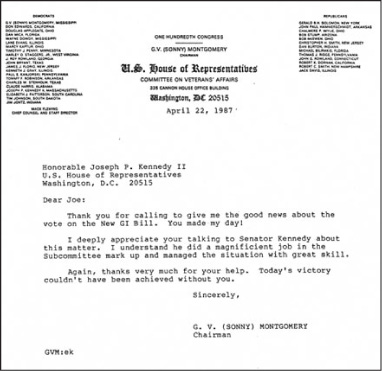
And I offered my thanks to Senator Edward (Ted) Kennedy in this letter. Senator Kennedy consistently supported my efforts and those of Senators Armstrong, Cohen, and Cranston over the seven years.
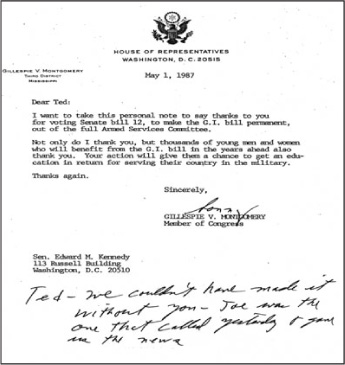
The Senator sent me a letter, too.
Note Senator Kennedy’s postscript at the bottom of his letter, in which he speaks of the significance of his nephew, Representative Joe Kennedy, serving on the House Veterans’ Affairs Committee and in fact pushing for a New GI Bill.
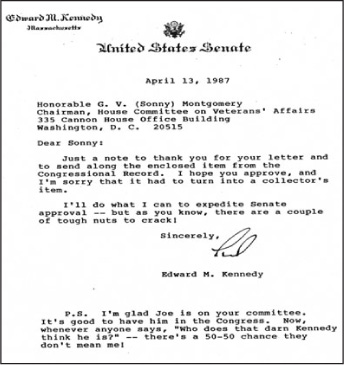
Mr. Kennedy
“Now when they say ‘who does that darn Kennedy think he is?’—there’s a 50-50 chance they don’t mean me!”
Mr. Montgomery

The full Senate convenes.
It’s now May 8, 1987, and the full Senate approves S. 12, as amended, 89 to zero!3
Here’s a sampling of what 11 Senators had to say during the debate on S. 12 in the Senate chamber prior to voting on it.
These are selected excerpts from each Senator’s remarks, not the full statements. We’ll start with Senators Cranston and Murkowski, who were the Democratic and Republican floor managers, respectively, for the bill, and then we’ll hear comments from nine other Senators who spoke on the bill.
Mr. Cranston

Alan Cranston
“The dividends our country has already reaped from past GI Bills [are] so vast as to be virtually incalculable. However, it is widely accepted that for every dollar spent in GI Bill benefits, the nation is returned $3 to $6 in increased tax revenues….
“While there has been a major emphasis on building a 600-ship Navy, for developing and acquiring the very best and fastest planes for our Air Force, and for purchasing the latest in high technology and weapons for our troops, we must not overlook the fact that we will always need to recruit the very best young men and women for positions of leadership and responsibility in our military in order to guarantee that America’s defense of today and tomorrow will remain strong. A New GI Bill will help us maintain this strength to defend our shores as well as those of our allies throughout the free world….
“Finally, the young people going to school under the New GI Bill will pay more in taxes over their lifetimes because more education will increase their income. Veterans’ Administration statistics show that in 1985, the median income for veterans with a high school diploma was $19, 720. For veterans who were college graduates, the median income jumped to $35, 800. This 83-percent increase in income associated with additional education results in significantly increased federal, state, and local income taxes flowing to government coffers.”4
Mr. Murkowski

Frank Murkowski
“The ability and wisdom to learn from experience are qualities that distinguish a wise and mature society. I believe they also distinguish this nation and this body. For over 40 years, we have been gaining experience in providing educational benefits to America’s veterans….
“Mr. President, this legislation is evidence that the nation’s commitment to veterans will continue. Our commitment is not just to those who served in the past, but also to those who will serve in the future. This legislation, and that commitment, have been brought to life by the perseverance and determination of the chairman of the House Committee on Veterans’ Affairs, Mr. Sonny Montgomery, whose name has already been inscribed on the new bill through his indelible record of action, and with the input of many years by his colleague on the minority Republican side, John Paul Hammerschmidt, and with the input of now ranking member, Gerry Solomon.”5
Mr. Montgomery
Thank you, Alan and Frank. And Jon Steinberg, Ed Scott, Babette Polzer, Jennifer McCarthy, Tony Principi, and Chris Yoder of your staffs, who all furnished helpful policy guidance on this issue. Jon Steinberg, in particular, helped in the final language of H.R. 1085 in that service members automatially would be “enrolled” in the Montgomery GI Bill (meaning eligible to use it), unless they specifically elected to “disenroll.”

Jon Steinberg
Next, we’ll hear from Senators Glenn, Armstrong, McCain, Thurmond, Cohen, and Kennedy, all members of the Armed Services Committee; Senators Matsunaga and Simpson of the Veterans’ Affairs Committee; and then Senator Daschle.

Ed Scott
Mr. Glenn

John Glenn
“… Mr. President, there was no doubt about the merits of extending the expiration date of existing authority in the Committee on Armed Services. The only question that was raised was whether or not the extension should be for a specified period, such as three years. That is the only question I raised in the subcommittee. There was some sentiment, which I shared, that we should make sure we know the effect of the current test program regarding both retention and overall costs before we move to make the program permanent.
“That is a big move. When we move to make something like this permanent, it becomes another entitlement program and it goes on into the years ahead. We have all decried the growth of entitlement programs in the past. We wanted to make sure that any new entitlement program was worthy of being included permanently in the budget of the United States of America. So we wanted to get a little more experience with this. That was the only reason we questioned whether this should go through or not.
“I would like to take a few minutes to share with you our reservations because I believe it is important that we have all of the facts on the record. In testimony that we received from the Congressional Budget Office (CBO) and from the Department of Defense, it is clear that the effect of the GI Bill on the recruitment of high-quality personnel for the military is inconclusive, except for the Army, where the benefit is supplemented by so-called ‘kickers,’ which add as much as one-and-a-half times the value of the basic benefit for certain categories of skills, or up to $24,200 for a $1,200 investment. Given the results, it was not surprising that when I asked the service personnel chiefs whether or not they would support the programs if the paying for it had to come out of that service’s budget and not the Veterans’
Administration which administers the program now, whether or not they would support the program if they had to pay for all of it, only the Army replied in the affirmative. The other services—the Marine Corps, the Air Force, and the Navy—said if they had to take it out of their own service budget, they did not feel it was doing them much good. The fact is there is considerable ‘economic rent’ in this program—we are offering a very attractive benefit to many people in order to get a marginal return on high-quality recruits….
“… So because of these uncertainties I was initially disposed in subcommittee toward putting a sunset on the extension of the current program so we could get a better handle on some of these concerns…. However, after weighing these concerns against the broader context of the benefit to our population of young people as a whole, the Committee on Armed Services and subcommittee I head decided to report out S. 12 without amendment….
“… I think this nation became largely what it is through education and basic research. Education in this United States of America is not just for the kids from the castle or the politically advantaged or well connected or the economically well off. It was for every single young person….
“… I do not know many who would argue against this, especially in light of what this administration has done to cut education. So it is on this basis that I was [the] one who proposed the amendment on the floor of the Senate in 1984 that became the basis for much of the current GI Bill that we are about to make permanent. It is the bill we worked on with Congressman Sonny Montgomery over in the House who has done yeoman’s service in this area, has been a proponent for this for a long time. We want to give him due credit because he has done a masterful job in that area….
“… Let me go through the procedures of what happened in the Senate Armed Services Committee because I think that was somewhat misunderstood by our colleagues over in the House side. We reported it out of our subcommittee with a recommendation, with a unanimous vote, of the Veterans’ Affairs Committee in the Senate and a unanimous vote of the Veterans’ Affairs Committee in the House, to approve this extension of the GI Bill. We approved it out of subcommittee with my vote in favor of it. When it got to the actual committee, one of our members objected basically on the grounds that maybe we needed more experience. That got some support. There was a considerable debate. We put off a final vote on that until another day. The objection that was raised in the first meeting was removed in the second meeting, and we voted out unanimously to approve this bill.
“… I am glad to be part of that support, the full support of the Committee on Armed Services for this bill on the floor today….
“… I am here to enthusiastically support passage of this bill today, and would urge all Senators to vote for it. I think one of the best things we can do is have a unanimous vote on this. Few things get unanimous around here. This is one that deserves it….”6
Mr. Armstrong

Bill Armstrong
“Mr. President, there is an old saying around Congress that bad legislation can become law in a day, but to get a good bill to become law takes years of hard work. That perfectly summarizes the legislative history of the GI Bill. It has taken four years7 of tireless work to sell Congress, the administration, and the nation on the simple notion that restoring the GI Bill is good for America.
“Today that work pays off.8 The Senate is about to pass legislation making the New GI Bill permanent.
“And well it should. The GI Bill pays educational benefits to those serving in the All-Volunteer Armed Forces. This is one of those rare pieces of legislation in which everybody wins—taxpayers, the military, and young service men and women, colleges, and the nation.
“In what may rank as one of the worst military decisions every made [by Congress], the GI Bill was terminated in 1976. Killing the GI Bill created a mammoth manpower crisis…. At the beginning, there were just four Senators besides myself willing to step into the breach and fight for the All-Volunteer Army: Senator Cohen, Senator Hollings, Senator Matsunaga, and Senator Cranston.
“I cannot begin to tell the Senate all the machinations, the parliamentary maneuvers, the hearings, the debate, the acrimony involved in getting the GI Bill restored. Fortunately, the fact, the proven record and the inherent wisdom of the GI Bill prevailed. In 1984, the New GI Bill was restored [as a test program]. So it is with particular satisfaction that I applaud the Senate making permanent the GI Bill.”9
Mr. McCain

John McCain
“Mr. President, it is with great pride that I join my colleagues in supporting S. 12 and H.R. 1085, bills that would make permanent the New GI Bill. These bills are, in large measure, the work of my good friends, Senators Strom Thurmond, Ted Kennedy, Representative Sonny Montgomery, and many others to whom we owe a large debt of gratitude.”10
Mr. Thurmond

South Carolina
“Mr. President, in the Armed Services Committee, consideration was given to maybe continuing it [the New GI Bill test” program] for [another] three years and then taking a look. But since it has been so successful and has done so much for the armed services, and has done so much to help so many young people get an education, we think it is better to go ahead and approve the bill. That is the reason I made the motion in the Senate Armed Services Committee that it be approved.
“Mr. President, I think this is a good bill. I think it is very helpful. I believe it benefits all concerned. Therefore, I hope our colleagues will pass this bill as it is now written.
“Mr. President, I yield the floor.”11
Mr. Cohen

Bill Cohen
“Mr. President, the legislation we are considering today is one of the most significant measures the Senate will act on in the 100th Congress….
“When I first introduced legislation in 1979 to restore [non-contributory GI Bill] benefits, our military services were facing serious problems, and both from the standpoint of quality and quantity, they were unable to recruit the people they needed….
“Secretary of the Navy John Lehman testified [in the Senate Armed Services Committee] that if he had to choose between having new ships or having more and better qualified people, he would take the men and women each time. And the Army Chief of Staff, Gen. Edward “Shy” Meyer, told us of the ‘hollow Army’ which was desperately in need of GI Bill benefits to encourage educationally motivated men and women to consider Army service.
“Despite these calls for assistance, the fight to restore GI Bill benefits was not an easy one. In 1983, Bill Armstrong and I stood on the floor, making what we felt was a persuasive case for these benefits, only to be narrowly defeated on procedural grounds. We were joined by Alan Cranston, Spark Matsunaga, and Fritz Hollings, both in that floor battle and in other legislative efforts to bring these much deserved benefits to service personnel.
“Finally, in 1984, there was a breakthrough. Sonny Montgomery, who has really been the spearhead in this effort, won approval of his bill on the House side. We were not quite as successful here, but in the House-Senate conference on the Defense Authorization Bill for Fiscal Year 1985, we were able to win approval of a test program of educational benefits.
“The battle was not an easy one. It came down to the wee hours of the morning on the last day of the conference, and there were those who said they would close down the conference before they would agree to a GI Bill provision. Sonny stood his ground and the test program was accepted.
“We should remember that when GI Bill benefits were established in 1944, they were the initial step in the federal provision of educational assistance. Until 1965, the GI Bill stood virtually alone as a source of aid to post-secondary students. And as late as 1975, the Vietnam-era GI Bill provided over 50 percent of all student aid to those in post-secondary schools.
“It gives me great pleasure to see this once seemingly unattainable goal achieved today. The young men and women serving in our armed forces will have this important benefit as a recognition of the great contributions they are making to their nation through that service.”12
Mr. Matsunaga

Spark Matsunaga
“As the chairman of the Trade Subcommittee of the Senate Finance Committee, I have been involved in efforts to encourage and legislate such training programs [to promote America’s role in a modern international economy] but for a variety of reasons there has been some reluctance to implement them. In the GI Bill however, we have a wildly successful training program already at hand which has almost 43 years of history behind it. It would not do to let it slip out of existence.”13
Mr. Kennedy

Top Kennedy
“It is not often that we have an opportunity to pass legislation that both assists directly in our national defense and increases our competitiveness in the world marketplace.”14
Mr. Simpson

Alan Simpson
“Mr. President, I am pleased to add my wholehearted support to that of my colleagues for the New GI Bill Continuation Act.
“As a veteran and former chairman of the Senate Committee on Veterans’ Affairs, I appreciate the value of this measure to our nation and its veterans. I certainly appreciated being able to receive benefits under the original GI Bill, which enabled me to obtain my law degree at the University of Wyoming.”15
Mr. Daschle

Tom Dascble
“Every year we spend approximately $7 billion dollars on no-obligation educational assistance for college students. This, of course, is a worthy expenditure and a prudent investment in the future of our country. But we should not forget that it is also important that educational assistance be provided to those patriotic young people who have agreed to delay their education so that they can serve their country in a tour of military service.”16
Mr. Montgomery
Again, the final tally, 89 to 0 in favor of S. 12, as amended!17
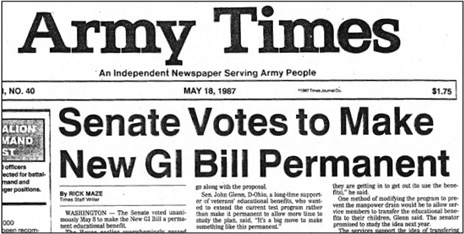
Let’s reflect a little now. Here’s what Mr. Rick Maze, congressional editor of the Army Times, wrote about the vote. It’s a helpful 20-paragraph article because it summarizes the many competing policy views associated with the bill:18
Mr. Maze

Rick Maze
“The Senate voted unanimously May 8 to make the New GI Bill a permanent education benefit. The House earlier overwhelmingly passed similar legislation.
“A short House-Senate conference will be necessary before the legislation becomes final to work out the one small difference between the House and Senate bills: the House wants to rename the New GI Bill the ‘Montgomery GI Bill’ in recognition of the efforts of Rep. G.V. ‘Sonny’ Montgomery (D-MS), the Veterans’ Affairs Committee chairman who has championed the educational benefits package. The Senate bill contains no such provision and is expected to go along with the proposal….
“… Sen. John Glenn (D-OH), a long-time supporter of veterans’ educational benefits, who wanted to extend the current test program rather than make it permanent to allow more time to study the plan, said, ‘it’s a big move to make something like this permanent.’

John Glenn
“Despite his doubts, Glenn said he based his final decision on the belief ‘the program will undoubtedly help a lot of young people get an education they would otherwise not get… whether it helps the services in recruiting or not, we ought to support this legislation,’ he said….
“… Glenn said he is concerned that the program may hurt the military in the long run by encouraging people to leave in order to use the benefits. ‘It cannot help but get people in, but they are getting in to get out [to use the benefits],’ he said.
“‘One method of modifying the program to prevent the manpower drain would be to allow service members to transfer the educational benefits to their children,’ Glenn said. The senator promised to study the idea next year….
“… The services support the idea of transferring the benefits, believing that earning educational benefits that could later be given to children could also be a recruiting tool as well and keep members from feeling compelled to leave the service to use the benefits.
“Sen. Alan Cranston (D-CA), the Senate Veterans’ Affairs committee chairman, said making the bill permanent is an important symbol of support for people who volunteer for military service, and that offering the educational benefits will help the services ‘meet the challenge’ of continuing to operate without a military draft….

“… Senate passage became assured after the legislation cleared what could have been a major stumbling block in the Armed Services Committee.
“The Armed Services Committee unanimously approved making the New GI Bill permanent only after a massive lobbying effort by military organizations, lawmakers who supported the bill, and even Pentagon officials who once opposed making the program permanent.
“… Chapman B. Cox, DoD’s top military manpower official, told military legislative liaison officers to quietly let Senators know that the Pentagon supported making the current program permanent, even though the official administration position was to reduce program costs, military sources said.
“Key Senate aides said the Pentagon switch probably had little effect on the outcome or the vote because the private position of the services was already known. However, Cox’s decision to lobby for the legislation did not escape notice at the White House Office of Management and Budget….
“… OMB Director James Miller called Defense Secretary Caspar Weinberger to complain about Cox’s failure to follow the Administration line, although Weinberger did not take the criticism very ‘seriously,’ said a key official involved in the last-minute lobbying effort.
“Most of the pressure was aimed at Sen. Strom Thurmond (R-SC), a senior Armed Services Committee member who shocked the bill’s supporters by speaking against the measure in a closed-door session….
“… Although other committee members, particularly Chairman Sen. Sam Nunn (D-GA), and Glenn, chairman of the Manpower and Personnel Subcommittee, also objected to making the program permanent, Thurmond’s opposition seemed out of character to supporters and opponents because he was one of the bill’s 58 cosponsors.
“Nunn delayed the committee vote on the measure for four days after the Senators present appeared evenly divided on the issue and key supporters, including Sen. Edward Kennedy (D-MA), were unable to attend the session, aides said.
“… The four-day delay allowed supporters to pressure Thurmond to switch his position, and the pressure worked. He dropped his opposition in the committee and spoke in favor of the measure on the Senate floor, expressing no reservations about indefinitely continuing the program.
“The New GI Bill took effect July 1, 1985, in what was to have been a three-year test period. Under the voluntary program, active-duty recruits who forfeit $100 a month in pay for one year are eligible for basic, post-service deduction benefits of $300 a month for three years of active service or a combination of two years’ active and four years’ inactive service. The basic benefit is $250 a month for three years for a two-year active-duty enlistment….
“… In addition to the basic benefits, the Army and Navy offer supplemental benefits for those who enter critically needed skills. The maximum monthly post-service benefit legally can be as much as $1, 300, although a $400-a-month supplement is the current limit [on the $1, 300].
“For Reservists, no contribution is required. Those who enlist for six years can receive $140 a month in educational benefits without having to wait until the obligation is completed.”
Mr. Montgomery
On May 13, the House and Senate resolved minor differences between H.R. 1085 and S. 12, both as amended.19
Th 89-0 Senate vote on May 8 mentioned earlier was anticlimactic. Any members who may initially have had reservations in the Armed Services Committee voted “aye.”
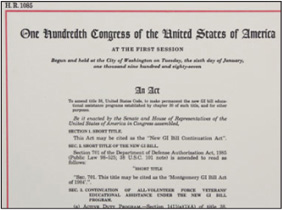
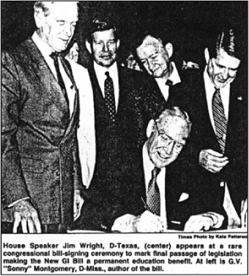
H.R. 1085—the enrolled bill—is signed on May 19, 1987, by Speaker of the House Jim Wright (D-TX).
H.R. 1085—the enrolled bill—was signed on May 19, 1987,20 by Speaker of the House Jim Wright of Texas and President Pro Tempore of the Senate John Stennis of my home state of Mississippi, which we’ll see in a minute. Thirty-six House members and Alan Simpson attended the enrolled-bill signing ceremony in Statuary Hall at the Capitol.21 In addition, some 40 representatives of military personnel associations, veterans’ organizations, each service branch’s leadership, service branch GI Bill program managers, the higher education community, and service members participating in the New GI Bill were present, as well.22
How does the President know whether to sign a bill?
The Office of Management and Budget’s Assistant Director for Legislative Reference sends the enrolled bill to the cabinet department (or departments) that would have responsibility for implementing the bill and who would be most affected by it.
In this case, OMB, housed at the New Executive Office Building, sent the enrolled bill (H.R. 1085, as amended) to the Veterans’ Administration and Defense Department. VA and DoD had two days to comment on H.R. 1085 with the following OMB-furnished guidance: “Your cooperation in meeting this deadline is needed to provide maximum time for the Presidential action on the enrolled bill.”23
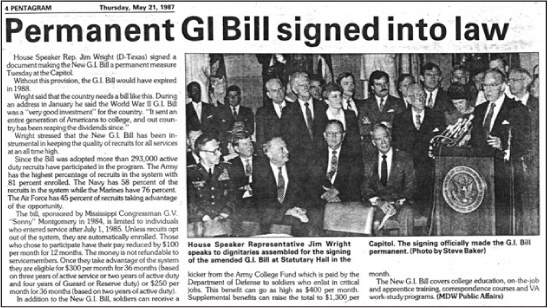
Here is some paraphrased language from Administrator of Veterans Affairs Tom Turnage’s May 20, 1987, letter to OMB director Jim Miller:24
Mr. Turnage

Tom Turnage
“We favor making the New GI Bill a p e r m a n e n t program…. We recommend that the President sign this enrolled bill…. We have prepared, for your consideration, a proposed signing statement which is enclosed.”
Mr. Montgomery
Needless to say, President Reagan planned to sign the bill and Vice President George H.W. Bush recommended a signing ceremony in the Rose Garden.
Howard Baker, Chief of Staff to President Reagan, sent the following memorandum to Vice President George H.W. Bush on May 14, 1987—six days before Administrator Turnage had commented on the bill:25
Mr. Baker

Howard Baker
“I concur with your recommendation that there be a signing ceremony at the White House, and I have asked Will Ball to take the necessary steps to bring it about. I do not have the details yet as to timing and the size of the crowd that the President will invite, but we can work that out.
“You can be sure that Sonny will get a fair share of the credit for this hard-fought legislation. Thanks for the heads up.”
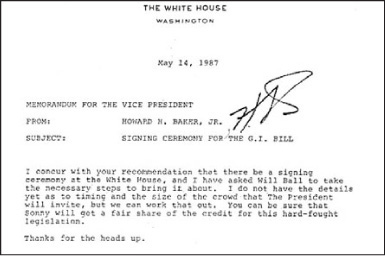
Memo about the signing ceremony.
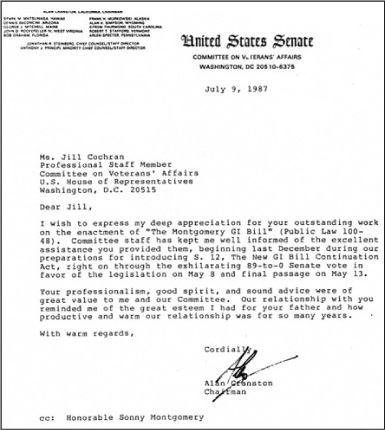
Appreciation letter to Ms. Cochran from Senator Cranston.
In our bicameral legislature, I found it heartening when an elected member of one body took the time to commend a staffer in the other body.
On the previous page is the letter the chairman of the Senate Committee on Veterans’ Affairs sent Ms. Cochran of our Veterans’ Affairs Committee staff.26
I am indebted to Ms. Cochran’s considerable skills and good counsel in getting our bill to the White House.
Further, here is the note Vice President George H.W. Bush personally typed to me regarding a Rose Garden signing ceremony… 27
Vice President Bush
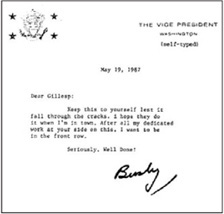
“Dear Gillesp: Keep this to yourself lest it fall through the cracks. I hope they do it when I’m in town. After all my dedicated work at your side on this, I want to be in the front row. Seriously. Well done!” Bushy
Mr. Montgomery
Since my first name is Gillespie, the Vice President always called me “Gillesp.”
Indeed, Vice President Bush played a valued “behind-the-scenes”-type role within the Administration in getting the legislation passed.28 And, in the process, I believe he helped give many young Americans a four-year, post-service education opportunity they might not have been able to afford.
On June 1, 1987, in a Rose Garden ceremony, President Ronald Reagan made what my colleagues and I referred to as a New GI Bill for the All-Volunteer Force the law of the land, as a permanent recruiting and readjustment tool. Said the President:29
President Reagan

President Ronald Reagan
“Thank you. Welcome to the White House…. In signing this bill, we’re providing not only for the future of our service men and women, but for America, too… our military forces are only as good as the men and women who man them, and in this high-tech age, we need an increasingly educated and motivated military guarding our country… I’ve had the privilege these last few years to visit often with our military men and women—from Quantico to the DMZ in Korea—and I can tell you they’re among the finest bunch that this country has ever seen….(applause)”
“I want to pay a special tribute today to Congressman Sonny Montgomery… your great efforts have made this day possible… and now, that’s enough out of me. I’ll start writing and sign the bill (applause).”
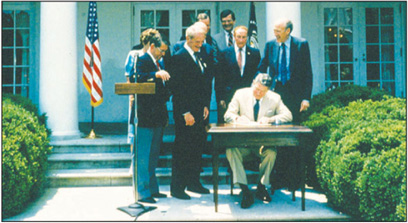
President Reagan signs the Montgomery GI Bill June 1, 1987.
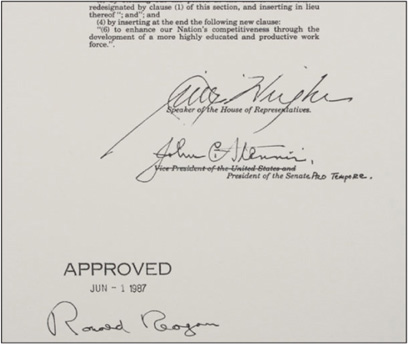
President Reagan’s signature on the Montgomery GI Bill.
Mr. Montgomery
Was making the GI Bill permanent in 1987 a good public policy?
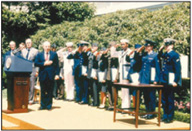
President George H.W. Bush commemorates the one millionth service member to sign up for the Montgomery GI Bill.
On June 5, 1990, President George H.W.
Bush, flanked by then–Secretary of Defense Dick Cheney, led a ceremony commemorating the one millionth service member to sign up for the Montgomery GI Bill, as of that day. The Montgomery GI Bill is all about the service members. Indeed, they are engaging and resourceful people.30 Said the President:31
“Today, the Montgomery GI Bill ranks among the most practical, cost-efficient programs ever devised and represents one of the best federal investments since Betsy Ross bought thread and needle.”
I want to say a few words about Secretary of the Army John Marsh. His quiet leadership was critical to the enactment of the Montgomery GI Bill.
In regard to their leadership style, I think Secretary Marsh and General Max Thurman perhaps, too, were a bit like the “skunk at the picnic” that Secretary Powell referred to earlier.
A former Congressman from Virginia, John Marsh served as Secretary of the Army from January 1981 until August 1989, the longest of any military secretary in U.S. history. Republican President Reagan selected Marsh, a Democrat, for this position.32
John and I worked closely together, even though he was part of the Executive Branch and my colleagues and I were in the Legislative Branch. Secretary Weinberger gave Secretary Marsh the support he asked for—and needed—in supporting our legislation.33
Mr. Marsh
“Sonny Montgomery knew more members of Congress than anyone else. Sonny had an affable nature. And he liked people. Every time he saw his friend George H.W. Bush he mentioned the need for a New GI Bill. Heck, as a former member, President Bush could have had his own locker in the House gym, but he just shared Sonny’s!”34

John Marsh
“Sonny was like the ‘Fuller Brush salesman’ of saving the All-Volunteer Force. If I saw Sonny in the coffee shop or at a Kennedy Center gala, he’d be talking about the same thing—a New GI Bill.”35
Mr. Montgomery
Colonel Michael Meese, Ph.D., a labor economist and head of the Social Sciences Department at the U.S. Military Academy, sums up:36
Col. Meese
“Transitioning to the All-Volunteer Force was the most important change the Army made since World War II; the Montgomery GI Bill was the policy vehicle that allowed this to happen.”
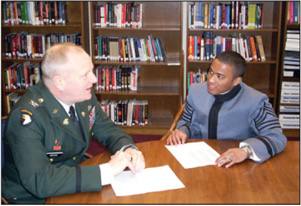
Col. Meese and Cadet Shawn Goodin in 2008.
Writing a law that took seven years called for a celebration and distributing replica versions of the signed law.
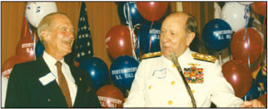
Sonny celebrates the signing of the Montgomery GI Bill with Admiral Richard Crowe, chairman of the Joint Chiefs of Staff.
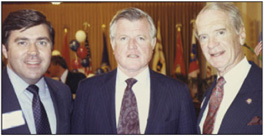
From left, Rep. Roy Dyson (D-MD), Sen. Ted Kennedy (D-MA), and Sonny.
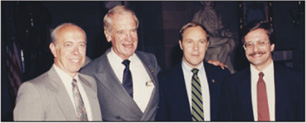
Sonny with, from left, Mack Fleming, Rep. Claude Harris, Jr. (D-AL) and HVAC staff member John Brizzi.

Sonny with Mary Stout, Vietnam Veterans of America.
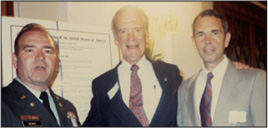
From left, Lt. Col. Al Bemis, Sonny, and Lt. General Bob Elton.
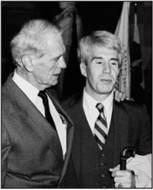
Sonny with Tom Miller, Blinded Veterans Association.
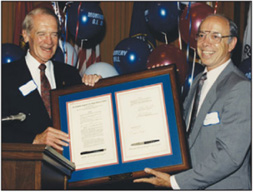
Sonny and HVAC staff Mack Fleming with a replica of the signed Montgomery GI Bill.
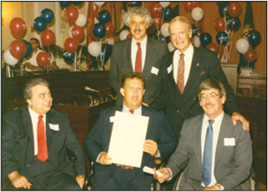
Front row, from left, Paralyzed Veterans of America staff Frank DeGeorge, Bob Moran and Gordon Mansfield. In back with Sonny, Doug Vollmer.
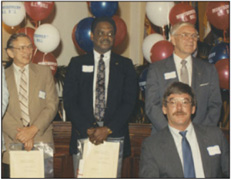
From left, Mylio Kraja, American Legion; Chuck Jackson, NCOA; Cooper Holt, VFW; and Gordon Mansfield, PVA.
Principle and merit count in a democracy, including when they
may hurt the elected official politically.
Even though the military personnel, veterans, and higher education organizations favored our bill, Chairman Glenn still had doubts, as did Sentaors Tower, Nunn and others.
Senator Glenn sponsored the Citizen-Soldier GI Bill amendment as part of the FY 1985 DoD Authorization Act. But Mr. Glenn felt the “economic rent”—that is the annual, recurring cost of an improved post-service education incentive—was too high, relative to the numbers of new enlistees our military would get annually.
In my view, my colleagues and I were right, on principle and merit. And we also had the support of the groups that I mentioned above because they thought we were right on the merits of our proposal as well, especially after we tested the New GI Bill concept for two years.
Nevertheless, I very much appreciate Chairman Glenn’s resolve because he continued to carry on the debate with the many groups that opposed his view. He initially could have relented to the pressure they exerted. But he didn’t do so. It appears the chairman didn’t think the New GI Bill test program was successful enough to make it permanent public policy.
I suspect the chairman would say he put the merits of the issue first. Not everyone would be willing to do so. I admire that.
WHAT’S NEXT
The service branches and the United States Department of Veterans Affairs implement the Montgomery GI Bill. Let’s see how well it turns out.